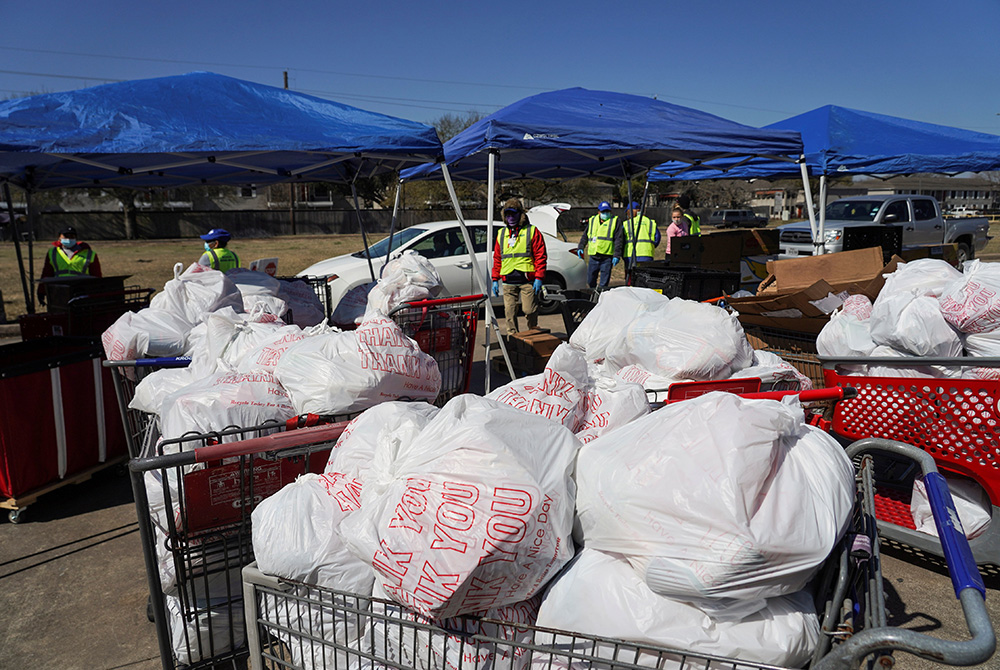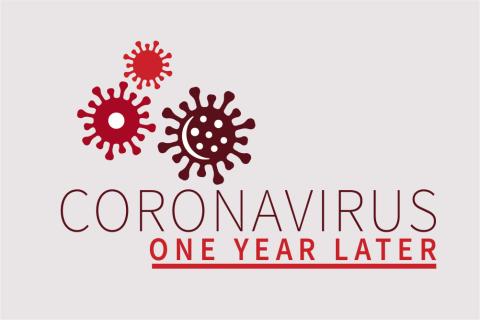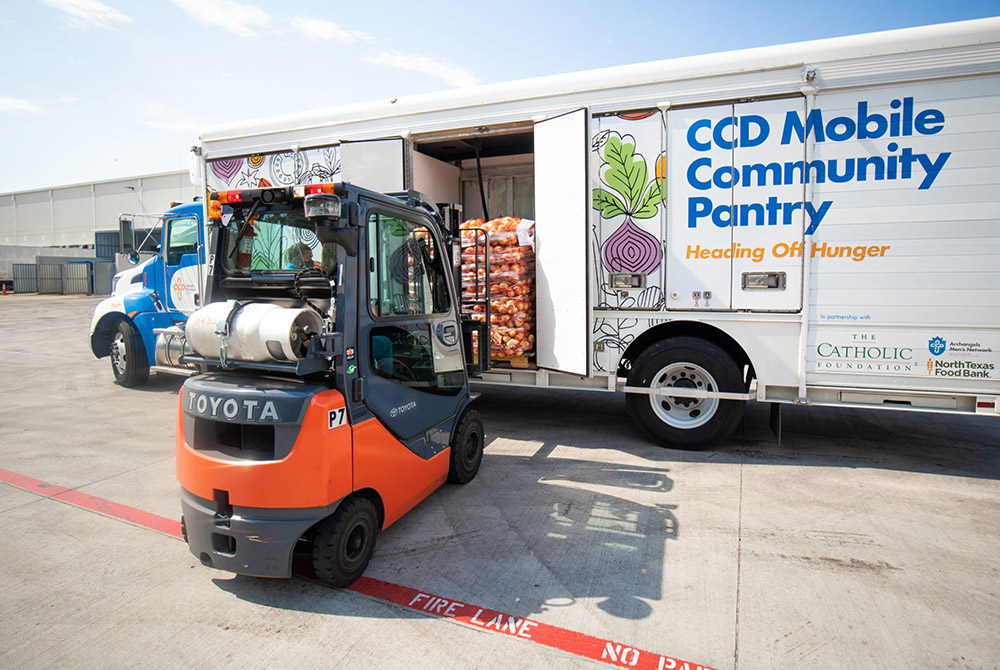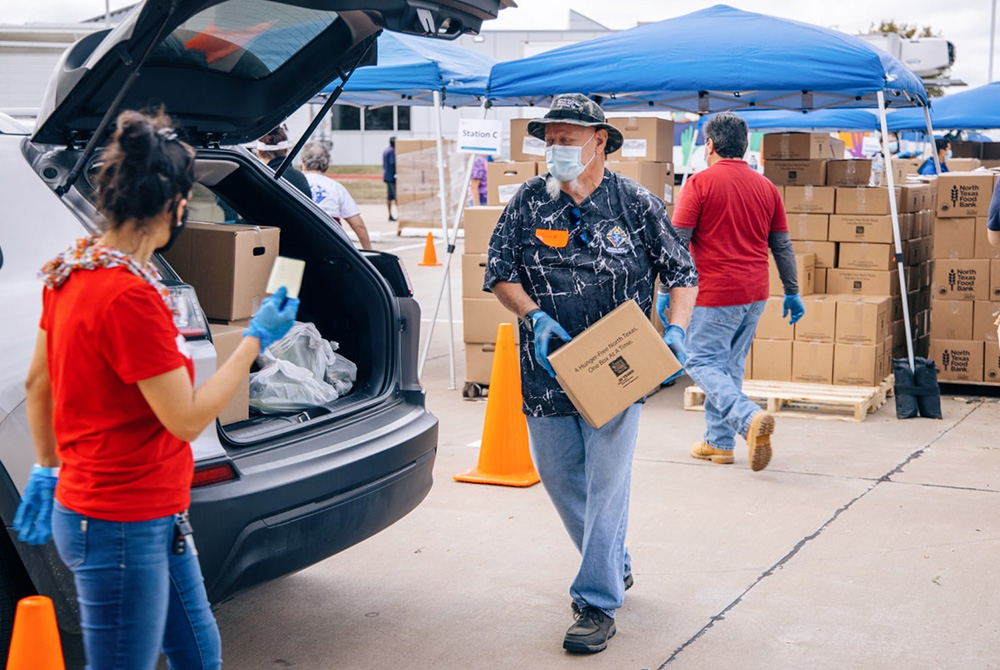
Food packages are seen at a food distribution site Feb. 19, after winter weather caused a shortage of food and clean water in Houston. (CNS/Go Nakamura, Reuters)

(NCR, GSR logo/Toni-Ann Ortiz)
Nearly a year after the coronavirus pandemic brought the world to a halt, the need for food assistance remains high in Texas.
It's why Catholic Charities Dallas and its local food bank partners are holding their second "mega-food event" March 12, expecting a repeat of the first one in November when they distributed 70,000 pounds of food to more than 1,000 families in one day. Edwin Chinchilla, a senior program manager for Catholic Charities who coordinates its food programs, thinks they may even surpass those numbers.
As the pandemic has roiled on, "the need for food has increased tremendously," he told EarthBeat.
The massive food drive, with long lines of cars expected at the Dallas Love Field Airport, is a sign that even as vaccine rollouts ramp up across the country, and some states like Texas have begun shedding their COVID-19 restrictions, the ancillary pains of the pandemic linger on for families. A recent report from Save the Children found 21% of Texas households with children reported they did not have enough food to eat.
Looking back at the last year, Chinchilla is proud of how his team and its partners have served more than 150,000 families in their community. He also recalls the tense, overwhelming feelings in the early days of March and April 2020, when they scrambled to improvise ways to feed so many people so quickly.
"A tsunami of need is what we called it," he said.
The pandemic strained the complex food supply systems in the U.S. and other parts of the world, rippling from farms to family tables and exacerbating the impacts of extreme weather like drought and flooding. Experts say the pandemic has also offered a glimpse of food supply problems that can be expected as global temperatures continue to rise.
Scenes similar to those in Dallas played out throughout the country.
In the early days of the pandemic's first year, people rushed to grocery stores and emptied shelves as they worried of food shortages and stores closing. COVID-19 outbreaks in meat-packing facilities led to price spikes and stores rationing how much customers could buy.
As schools shut down, many still tried to find ways to provide students with the lunches on which families relied. And as in Dallas, cars lined up for miles outside food banks and other impromptu distribution centers, like Wrigley Field in Chicago, as people sought any outlet to feed their families as jobs were lost and work hours dropped dramatically.
Since the pandemic began, Catholic Charities Dallas has distributed 3.6 million pounds of food, a 250% increase over pre-COVID-19 amounts. Nationwide, Catholic Charities estimates that in the past year it served approximately 18 million people — double its typical yearly average.

Staff with Catholic Charities Dallas load boxes of food into cars of families at a distribution center in July 2020. Since the coronavirus pandemic triggered shutdowns across America last March, the agency has distributed 7 million pounds of food to more than 150,000 families. (Courtesy of Catholic Charities Dallas)
Supply chains break down
Disruptions caused by outbreaks of the virus and lockdowns to contain it were felt throughout the food supply chain.
Farmers struggled to obtain necessary inputs for growing crops or tending herds, and seasonal workers weren't able to help with the harvest. Getting food to markets became a problem, as packagers accustomed to filling bulk orders for restaurants — which closed amid quarantine restrictions — could not retool quickly to provide consumer-size packages.
As supply chains shrunk, demand for food assistance grew.
"That was quite daunting when you think budgets didn't double," said Jane Stenson, vice president for food and nutrition and poverty reduction strategies for Catholic Charities USA.
For local Catholic Charities agencies, the closure of schools and restrictions on social gatherings meant food drives and other reliable sources of donations also came to a halt. The emergency led them and other food distribution services to get creative and explore new partnerships.
Restaurants forced to close but looking to keep staff employed became a source for meals, including in the Chicago Archdiocese. In September, the Church of Jesus Christ of Latter-day Saints in Salt Lake City sent a semi-truck filled with 14 pallets of nonperishable food to Catholic Charities of Buffalo and other food pantries in western New York.
Farmers with crops and milk at risk of spoiling also made contributions, and many Catholic Charities joined the U.S. Department of Agriculture's Farmers to Families program, which has delivered more than 144 million boxes of food to families during the pandemic.

Increased demand for food assistance over the past year due to the coronavirus pandemic led Catholic Charities Dallas to double its fleet of mobile food trucks to four. The trucks help the agency deliver food to 59 sites across eight counties within the Diocese of Dallas' borders. (Courtesy of Catholic Charities Dallas)
Along with providing bags of food, Catholic Charities agencies helped people apply for assistance from USDA programs, like the Supplemental Nutrition Assistance Program, or SNAP.
While some parts of the food safety net proved resilient, Stenson said it broke down in rural communities, where food banks and grocery stores are less prevalent, and they often lack the refrigeration storage capacity to accept large donations. It also takes longer to serve less densely populated regions.
"You can spend five days a week, eight hours a day doing rural distribution but know in a state like Texas you've only touched a handful of communities," Stenson said.
During the pandemic, Catholic Charities Dallas doubled its fleet of mobile food trucks to four, which made it easier to make deliveries to 59 locations across the eight counties in the diocese.
The scenes of cars lined up, waiting for food, around the nation did not shock Stenson. "All it takes is you miss a paycheck or two, and we're all right there," she said.
What was shocking, said Norman Wirzba, a theology professor at Duke University and author of multiple books on food and faith, was how quickly COVID-19 pushed pressure points "that really put people over the edge."
"While people may have understood that there were many vulnerabilities in the [food] system, whether those be biological or ecological vulnerabilities but then also social and economic ones, I think we're seeing how it just does not take very much to push the buttons that put people and communities in serious trouble," he said.
The question, Wirzba added, is whether the pandemic offered "sort of a foretaste" of the intensifying troubles that are expected with increasing climate change.
According to the University of Notre Dame's Global Adaptation Initiative, various factors that make countries vulnerable to climate change, including food dependency, are similar to those that increase vulnerability to a pandemic.
Advertisement
Food insecurity rises
Even before the pandemic, 149 million people, including refugees, in 79 countries faced acute food insecurity. COVID-19 was expected to push that total to 272 million by the end of 2020 in those countries, according to a February World Bank report.
On March 10, Catholic Relief Services released a new report that identified 31 "hot spot" countries at risk of increasing food insecurity, 14 of which it said were "on the brink of widespread hunger." Most are in Africa and South America.
"The pandemic has created food insecurity in more places than were previously seen, but what it seems to have mostly done is exacerbated existing inequalities," said Austen Moore, a CRS senior technical adviser specializing in agricultural livelihoods.
The CRS report called the pandemic "an exacerbating factor for acute food insecurity," adding to other major drivers like conflict, economic downturn and climate change.

Staff with Catholic Charities Dallas load boxes of food into cars of families at a distribution center in July 2020. (Courtesy of Catholic Charities Dallas)
The pandemic coincided with the second-hottest year on record. Scientists expect climate change to further disrupt food security, as changes in temperatures and rainfall patterns alter growing seasons and as more frequent extreme weather events wipe out crops and complicate food delivery.
Lori Pearson, CRS senior policy adviser for food security and climate change, told EarthBeat that, like the pandemic, global warming exposes inequities in the food system and affects already vulnerable populations the most.
Before the global coronavirus outbreak, climate change was already contributing to a long-term trend of declining yields for smallholder farmers, Pearson said, adding, "Overall this cycle of downward trends is being accelerated."
Smaller harvests mean less income, making farmers more vulnerable to disruptions like those caused by the pandemic. Catholic Relief Services works with farmers to restore degraded land, but the pandemic has made it difficult to conduct collective activities.
Lessons from the pandemic
In September, the United Nations will hold a first-ever Food Systems Summit focusing on ways to step up efforts to meet the Sustainable Development Goal of ending hunger by 2030. Lessons learned from the pandemic are likely to come up.
As part of its "hot-spot" countries report, Catholic Relief Services called on governments to increase humanitarian efforts to provide food and nutrition assistance as countries face new waves of the coronavirus and its variants. They recommended that nations work to minimize food chain interruptions by providing support for food storage, processing and transport, and through advocacy for open trade corridors.
The CRS report also requested the U.S. provide at least $20 billion in emergency funding for COVID-19 response overseas "so that decades of development gains are not lost," and to prioritize holistic, multisector approaches to nutrition and food security.
Moore, the CRS technical adviser, said the pandemic has highlighted the need for better planning to reduce the risk of disasters, so communities and food systems can be better prepared for future catastrophes. It has also shown how countries, when pressed, can collaborate in responding to an international emergency.
Meanwhile, the experience of distributing food during a pandemic has led Catholic Charities USA to explore ways of expanding its capacity to accept more diverse products and transport them to underserved areas.
Stenson said she hopes the USDA will continue measures it took to make it easier for government aid recipients to obtain food, such as using SNAP benefits to buy groceries online; allowing them to make virtual appointments; or waiving rules about parents picking up school meals for their children.
Wirzba, author of the 2018 book Food and Faith: A Theology of Eating, said religious organizations have "a major role" to play, not just as sources of charity, but in policy discussions about food resilience and food justice stemming from the pandemic. Faith communities are better positioned than other groups, he added, to make sure values are a part of those conversations.
"We need folks who can engage these issues from the perspective of values, from what matters," he told EarthBeat. "And that's what faith traditions are uniquely suited to do."






